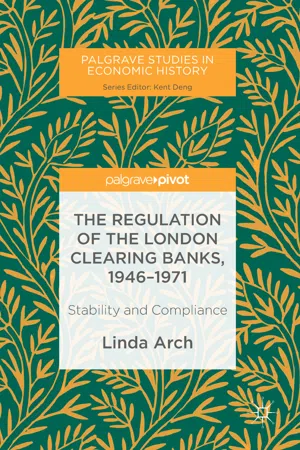The period from 1946 until the early 1970s was a period of stability in banking in the UK and one in which there was a high degree of compliance with regulation. During the 1970s, in contrast, the banking system became less stable as the post-war regulatory framework disintegrated or was dismantled, and in December 1973 a crisis of the secondary banks broke. The stable earlier period also stands in contrast to the period since the 1970s, which has been more prone to banking crises, most notably the global financial crisis of 2007–2009. The primary purpose of this book is to contribute to our understanding of the nature of clearing bank regulation in the earlier stable period from 1946 until the early 1970s.
The focus of this study is a specific group of banks referred to as the London clearing banks. Who and what were these banks? In 1946, at the beginning of the period under review, there were eleven London clearing banks (Barclays;
Coutts & Co.;
District; Glyn, Mills & Co.; Lloyds; Martins; Midland; National; National Provincial; Westminster; and Williams Deacon’s).
1 In 1962, National Provincial acquired
District Bank reducing the number to ten. There was then a flurry of merger activity in the late 1960s, with the mergers of National Provincial with Westminster in 1968, Barclays with Martins, and the merger in 1969 of three smaller clearing banks,
Williams Deacon’s, Glyn, Mills & Co. and National to
form Williams & Glyn’s Bank Limited. By 1970, six London clearing banks remained: Barclays,
Coutts & Co., Lloyds, Midland,
National Westminster and Williams & Glyn’s. The term “clearing bank” is rarely used today but the clearing banks were what would now be thought of as retail banks. These banks were termed “clearing banks” because of their membership of the London Bankers’ Clearing House. On a daily basis, cheques between the clearing banks were exchanged at the London Bankers’ Clearing House, and balances between them were settled. As
London clearing banks, these banks were required to have a principal office in London, a legacy of London’s position as a leading international financial centre during the nineteenth century and up to the First World War.
2 It did not mean that their operations were confined to London. The relative size of the eleven London clearing banks at the beginning of the period based on the value of their current, deposit and other accounts is illustrated in Table
1.1.
Table 1.1London clearing banks’ current, deposit and other accounts, 1944
Clearing bank | Current, deposit and other accounts 1944 (£) |
|---|
Midland Bank | 1,002,825,685 |
Barclays Bank | 917,775,560 |
Lloyds Bank | 819,285,356 |
Westminster Bank | 598,934,131 |
National Provincial Bank | 589,911,940 |
Martins Bank | 204,264,101 |
District Bank | 169,736,171 |
Williams Deacon’s Bank | 80,471,749 |
Glyn, Mills & Co. | 62,576,130 |
National Bank | 56,324,458 |
Coutts & Co. | 38,971,424 |
Why focus on this particular group of banks? The reason for a focus on the London clearing banks is that for most of this period the London clearing banks were the dominant group of banks within the UK banking sector on a number of measures. They were, for example, the dominant group of banks by assets. 3 They were the primary source of loans and advances: as at mid-December 1964 the London clearing banks were responsible for 67.3% of the £7.4 billion of bank lending to UK residents, excluding lending to other banks. 4
Given that the stability of the banking system is a key guiding principle of bank regulation, it follows that a very stable period should be of interest to historians, policymakers and regulators. Reinhart and Rogoff, based on their analysis of sixty-six countries, showed that the absence of banking crises from the 1940s until the early 1970s was a noticeable feature of many banking systems.
5 Grossman has suggested that this period “constitutes the longest sustained period of banking stability this industrialized world has ever known.”
6 Alan M. Taylor observed in 2010: “the post-war period of
financial repression (including capital controls but also strict regulation of domestic finance) was a remarkable era in combining rapid economic growth and high investment with a crisis-free but strictly regulated and supervised financial system in most countries. This is a remarkable historical fact that warrants further study.”
7 The start date of the study—1946—was significant as the year in which the Bank of England Act was enacted by the Labour government under Prime Minister
Clement Attlee. Among other things, the Act established the regulatory relationship between banks on the one hand and the
Bank of England and the Treasury on the other. The study ends in 1971 with the
Bank of England’s radical new policy
of Competition and Credit Control (CCC). During the 1970s, the UK and other countries experienced a decline in the stability of their banking systems. In 1973–1974, for example, there were several bank failures, particularly but not exclusively in Europe and North America—as detailed in Table
1.2.
8 Table 1.2Bank failures, 1973–1974
Date | Bank(s) involved |
|---|
December 1973 | United States National Bank of San Diego was declared insolvent and its assets were acquired by The Crocker National Bank of San Francisco |
December 1973 | The UK secondary banking crisis began |
1974 | While they did not fail, large foreign exchange losses were experienced at UBS, Westdeutsche-Landesbank Girozentrale, Hessische Landesbank Girozentrale (which had a large stake in the International Credit Bank of Geneva) and Lloyds Bank International |
June 1974 | On 26 June 1974 the Bankhaus ID Herstatt in the Federal Republic of Germany went bankrupt as a result of losses on foreign exchange transactions |
August 1974 | A private bank, Bass & Herz of Frankfurt in the Federal Republic of Germany, became insolvent |
August 1974 | The Israel-British Bank (London) Ltd. suspended payments following the liquidation of its parent, the Israel-British Bank. The subsidiary eventually received support from the Ban... |
